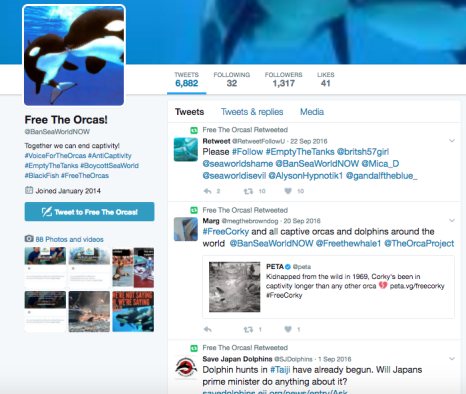“Communication theories are ways of conceptualising the relationship between the mass media and audiences” (Communication Theories) (1). Media theories are proposed by individual’s and are continuously refined in order to be useful and provide explanatory power to other’s (Turnbull, 2017) (2) . One such theory referred to as, “The Pubic Sphere“, fabricated in 1962 by German sociologist and philosopher, Jurgen Habermas, “…designates a theater in modern societies in which political participation is enacted through the medium of talk” (Rethinking the Public Sphere: A Contribution to the Critique of Actually Existing Democracy) (3) . One may argue it is the notion of an imagined space, a metaphor for an 18th century “coffee house”, where issues may be discussed and deliberated (Turnbull, 2017) (2).
Not long after the release of Blackfish (2013), a documentary which exposed SeaWorld’s cruel treatment of killer whales, a debate unfolded in the modern day public sphere through various social media platforms. Blackfish highlighted various incidents, including the death of orca trainer Dawn Brancheau, and used such events as a prism to critique SeaWorld’s historical treatment of orca’s (killer whales). In turn, this instigated the discussion as to whether or not killer whales should be kept in refined forms of captivity. With this, many individuals responded immediately, igniting an explosion surrounding this controversial topic, which in turn established various Facebook pages, such as “Empty the Tanks Worldwide“, Twitter hashtags, #VoiceForTheOrcas, #DontGoToSeaWorld and #ThanksButNoTanks and a multitude of individual opinions, “Orcas suffer hugely as a result of captivity. The amount of space they have is also ridiculous compared to what they have in the wild.” – Zoology Student, Helen Morrison (Killer Whale Captivity) (4).


The notion of the “public sphere” may be viewed as a direct form of communication for many individual’s, in which they are able to express their opinions across to millions of users world wide. This is evident, as nearly four years since the premier of Blackfish, people are still negatively posting and tweeting about the inadequate and unacceptable conditions SeaWorld holds for various animals. In response to the “flashpoint” sparked by the documentary, the theme park company had to deal with, “declining attendance, negative headlines, celebrity criticism, and pervasive social media trolling” (Fast Company) (5). As a result, SeaWorld launched a website, Ask SeaWorld, in the hopes of addressing issues of concern which individual’s may have and to ensure people that the company’s practices are ethical and in the best interests of the animals. Senior corporate affairs officer at SeaWorld, Jill Kermes, commented on the campaign, stating, “What we wanted with this campaign was to start that conversation with consumers and give them a place to go to get the facts about SeaWorld” (Fast Company) (5).
The following video is an example of content created in response to the ongoing debate surrounding killer whale captivity.
Media texts, including the likes of Facebook and Twitter, play an imperative role in being able to saturate a particular platform on a relevant and current issue. Individual’s who were triggered and provoked by the documentary, Blackfish, continue to explicitly express their thought’s through what is known as the, “modern day public sphere”, in turn, increasing attraction and discussion.
Brittany

(1) Lamb, B. (2007). Communication Theories | VCE Media, Victorian Curriculum, Media Arts, digital literacy, media education, filmmaking. [online] lessonbucket. Available at: http://lessonbucket.com/vce-media/units-3-4/media-influence/communication-theories/ [Accessed 3 Apr. 2017].
(2) (Turnbull, 2017)
(3) Fraser, N. (n.d.). Rethinking the Public Sphere: A Contribution to the Critique of Actually Existing Democracy. [online] Available at: https://www.jstor.org/stable/pdf/466240.pdf [Accessed 3 Apr. 2017].
(4) Davidge, J. (2015). SeaWorld; the Killer Whale captivity debate. [online] Scenes of Reason | The News Decoded. Available at: https://www.scenesofreason.com/seaworld-killer-whale-captivity-debate/ [Accessed 3 Apr. 2017].
(5) Titlow, J. (2015). SeaWorld Is Spending $10 Million To Make You Forget About “Blackfish” | Fast Company. [online] Fast Company. Available at: https://www.fastcompany.com/3046342/seaworld-is-spending-10-million-to-make-you-forget-about-blackfish [Accessed 3 Apr. 2017].

